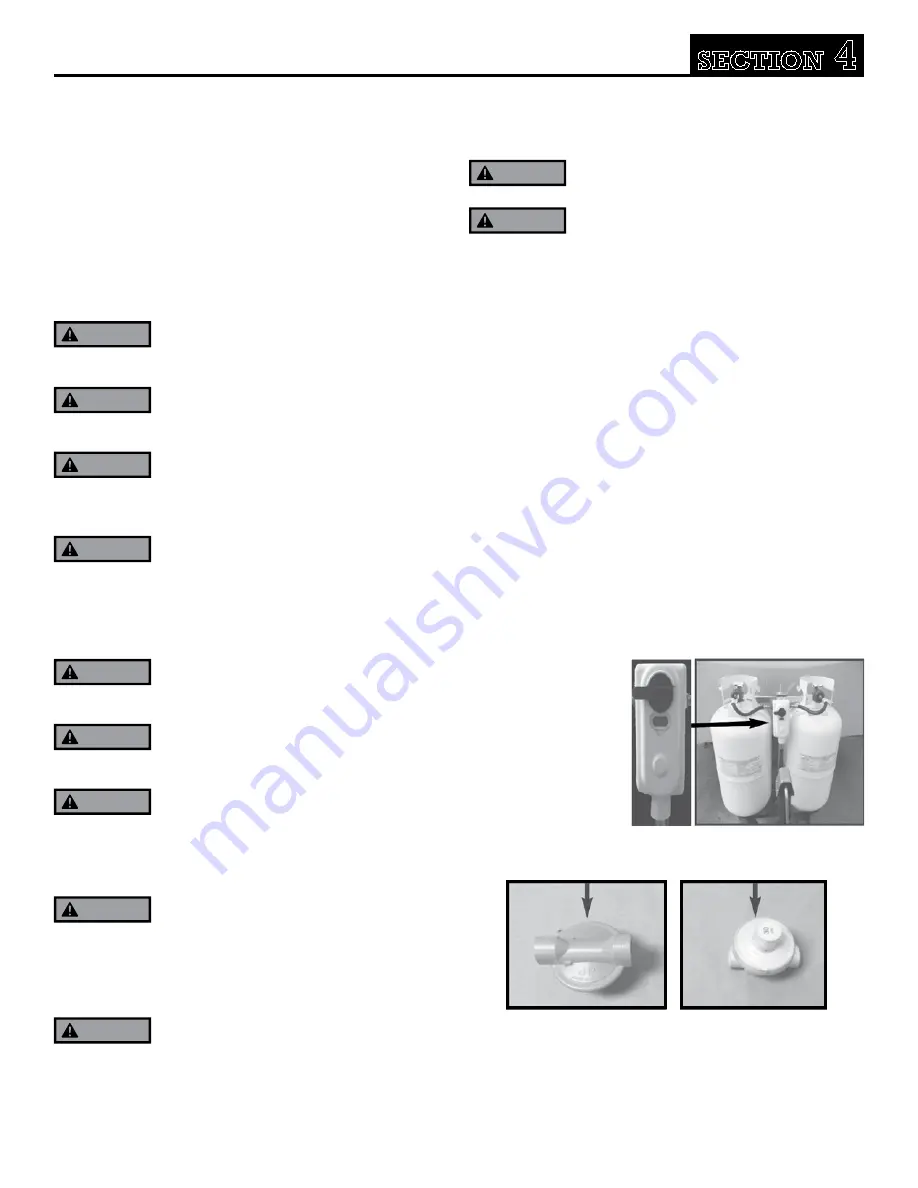
Page 21
Page 21
SECTION
4
Living Quarters, LP and Electrical
supply at the LP tank (or source). Immediately call a Service
Center or LP gas supplier from an outside telephone and
follow their instructions.
DO NOT
turn on the gas supply until the gas
leaks have been repaired.
DO NOT
attempt to adjust or repair the
regulator. Adjustments and repairs require
specialized training and tools. Contact a qualified LP Service
Technician. Failure to follow these instructions could result
in fire or explosion.
DO NOT MODIFY YOUR LP SYSTEM. DO NOT REMOVE
COMPONENTS OR REPLACE WITH COMPONENTS THAT
ARE NOT OF EQUAL VALUE.
The liquid petroleum (LP) gas system in your recreational
vehicle furnishes the fuel for cooking, heating and hot water.
LP gas can also be used as an alternate energy source for
refrigeration. It is a clean, efficient and safe form of energy
when proper handling and safety precautions are observed.
The gas is stored with extreme pressure in the tank, with
space in the tank to allow for expansion into vapor. This
vapor is reduced in pressure by passing through a regulator.
This reduction in pressure is a two step process which
assures consistent pressure for use, regardless of outside
temperatures, weather or altitude.
REGULATOR
LP gas is under high pressure in the tank. The purpose of the
regulator is to reduce
the pressure inside
the tank to allow for
safe use. A two-stage
automatic regulator,
most commonly used
on dual tanks, offers
the convenience of
instant, automatic
changeover from the
empty to the full tank.
LP DETECTOR
• This detector senses propane gas in the air, not smoke or
fire or other gases. It detects the presence of propane gas at
the sensor, explosive gas may be present in other areas.
• Test your LP detector weekly. If the alarm is located behind
a closed door, it may not be heard.
• DO NOT attempt to repair the detector. If it fails the test,
change batteries, if it still does not function properly, replace
the entire unit.
LP GAS (LIQUID PROPANE)
DO NOT
bring or store LP gas cylinders,
gasoline or other flammable liquids inside
the vehicle. A fire or explosion could result.
DO NOT
fill container(s) to more than 80%
capacity. Overfilling the LP tanks can result in
uncontrolled gas flow which can result in an explosion or fire.
NEVER
use any other type of LP gas
container than the one furnished with your
RV. If the tank must be replaced, check with your dealer for
specifications.
LP gas regulators must always be installed
with the regular vent facing downward.
Regulators that are not in compartments have been equipped
with a protective cover. Be sure the regulator cover is kept in
place to minimize vent blockage that could result in excessive
gas pressure causing fire or explosion.
DO NOT
rely upon being able to smell LP
gas leaks as the odor may not be sufficiently
strong enough to detect.
DO NOT
use butane or butane mixtures in
your LP tank. When you fill your tanks be
sure to use propane only.
DO NOT
make repairs to the LP tank. The
LP gas system is designed to meet rigid
standards. Except for simple maintenance and occasional
tightening of a connection, always take your vehicle to an
authorized dealer for LP gas problems.
Aways have an authorized LP gas supplier
fill your LP tanks. When the LP gas container
is being filled,
DO NOT
smoke, strike a match or ignite a
lighter. A spark or flame could ignite fumes. Also be sure
all burner and pilot flames are out and theservice valve is
closed.
If you detect a sulfur or ‘rotten egg’ odor,
DO
NOT
turn on any appliances. Shut off all
operating appliances. Extinguish any open flames, including
cigarettes.
DO NOT
touch any electrical switches. Open
windows and doors and exit the vehicle. Shut off the gas
WARNING
WARNING
WARNING
WARNING
WARNING
WARNING
WARNING
WARNING
WARNING
WARNING
WARNING
Two stage LP gas regulator most
commonly used on dual tanks
18 PSI (pressure per
square inch) single stage
LP gas regulator, most
commonly used on single
tanks
30 PSI (pressure per
square inch) single
stage LP gas regulator,
most commonly used
on single tanks
‘WARNING’ indicates a hazardous situation which, if not avoided, could result in death or serious injury.

































